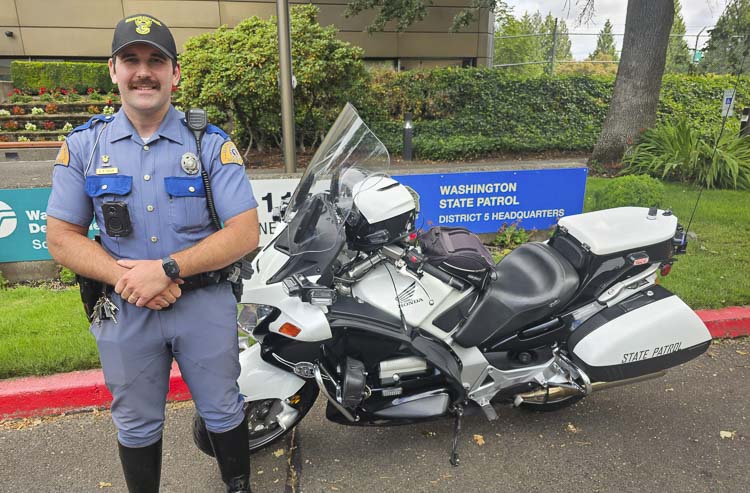
Washington State Patrol trooper Bennie Taylor Jr. wants all motorcyclists to ride safe
Paul Valencia
ClarkCountyToday.com
For those who know, there is something liberating about being on two wheels, riding on a dirt track, a course, or even on the streets and roadways.
“Motorcycles have been in my life since I was 3,” said Bennie Taylor Jr. “My dad bought me my first motorcycle for my third birthday.”
It was a small Honda dirt bike, and his dad taught Junior how to ride with that vehicle.

These days, Bennie Taylor Jr. is on a much bigger motorcycle, a 700-pound Honda with red and blue lights that he rides for work every day. His Honda looks pristine, because Taylor takes pride in its appearance, as he and that motorcycle represent the Washington State Patrol.
We are in the middle of motorcycle season in the Pacific Northwest.
Oh sure, there are plenty of motorcyclists who ride 12 months a year, but there are more motorcycles on the roads during the warmer months.
Target Zero, a campaign with the mission of having zero traffic-related deaths on Washington’s roads and highways by 2030, wants to make sure all motorcyclists get home safely, every day.
Taylor Jr. is the perfect spokesperson for motorcycle safety. He rides every day and he has decades of experience on two wheels. He has safety tips for motorcyclists as well as for those who drive cars, trucks, and SUVs to be on the lookout for motorcyclists.
Statistics show that most fatalities or serious injuries suffered by motorcycle riders are caused by the riders.
“In a sense, they almost think they’re invincible,” Taylor said. “They’re on a motorcycle. They’re going fast. I totally understand it. I used to do it when I did it on a racetrack. I’ve never done it on the highway because I know what can happen when you crash.”
Taylor understands the temptation.
“I understand, being on a motorcycle, you wanna go fast. I get that. But you still need to follow the law, the speed limit,” he said. “If you’re going the speed limit, somebody can judge how much time they have to be able to pull out in front of that intersection.”
When a rider is going twice the speed limit, for example, a driver of a car or truck might not be able to judge the proper amount of space before making a move.
“We know that speed is the No. 1 cause of fatalities in the state,” Taylor said.
Motorcyclists can also help themselves prepare for crashes by wearing proper attire.
They should wear gloves and long sleeves or a jacket, something that will protect the skin. Taylor also wears hi-viz motorcycle gear, giving others a better opportunity to see him and his motorcycle. Another tip is eyewear protection. That could come from a helmet with a visor, or safety glasses/goggles.
The helmet also must be approved by the Department of Transportation. Not any helmet will do. It must meet the DOT requirements to be efficiently safe.
Another point of emphasis for law enforcement this year is a crackdown on lane splitting. It is illegal in Washington, no matter how tempting it can be in heavy traffic, Taylor said.
“If a motorcycle is lane splitting and someone (in another vehicle) is trying to make a lane change, they don’t see it,” Taylor said. “They’re not even looking for you.”
Riders also can help themselves by ensuring they are not riding in another driver’s blindspot.
“If you can’t make eye contact (in the mirror) they cannot see you,” Taylor said.
Another easy tip is for motorcyclists to always activate the headlight, even in daytime.
There are also tips for drivers of cars, trucks, and SUVs to keep motorcyclists safe. Make sure you do a real good check of the blind spot. Don’t do just a quick over-the-shoulder check. Maybe do two checks, just in case. Motorcycles are smaller than other vehicles and a second look could make a big difference.
Blinkers can be life-savers, too. A rider could see a blinker and even if the driver of the car does not see the rider, the rider can slow or move out of the way before the car changes lanes.
Taylor said he is proud to be a part of Target Zero.
“It’s a great initiative to encourage law enforcement officers to do the very best they can every day, to be proactive, to go out and show that we are here in the community, we’re here to help, and we want everybody to be safe,” Taylor said.
Making the roads safer for everyone is a family tradition for Taylor Jr. His father is also a Washington State Trooper. His dad is an ace at getting drunk drivers off the road. Taylor Jr. grew up learning about the job and the responsibilities of being a first responder.
Junior always thought he wanted to follow in his father’s footsteps, but he still had to know for sure.
“Within the first two hours of my first shift as a pre-academy cadet … I knew right then and there that this is where I belong,” he said.
He was hired in February of 2019 as a pre-academy cadet, and he has been a trooper since March of 2020 after completing the academy. After six months in Marysville, he move back to Clark County. Last summer, he got the spot as a motorcycle trooper.
A dream job, for sure.
Bennie Taylor Jr. loves being a first responder and loves the motorcycle community. He is always ready to offer safety tips.
Target Zero gives him a bigger platform to combine the passions in his life.
Also read:
- WA Senate votes to set a 10% limit on annual rent increasesThe Washington Senate has approved a 10% annual rent increase cap as part of a controversial bill that now heads back to the House for final approval.
- Opinion: Employers shouldn’t pay workers not to work: Paying people to strike should be a union’s jobElizabeth New of the Washington Policy Center argues that Senate Bill 5041 would burden employers and taxpayers by using unemployment funds to pay striking workers instead of requiring unions to support their members.
- Matilda The Musical opens tonight at Ridgefield High SchoolRidgefield High School Theatre opens its six-performance run of Matilda the Musical tonight, celebrating student talent through this energetic and inspiring stage production.
- Clark County beginning installation of upgraded traffic signals in mid-AprilClark County will begin upgrading multiple traffic and pedestrian signals in mid-April to improve safety, accessibility, and transportation technology.
- Hiring event at WorkSource Vancouver on April 16WorkSource Vancouver will host a free hiring event on April 16 with opportunities to meet local employers and apply for a wide range of jobs.
- Clark County and The Cowlitz Indian Tribe host open house April 24Clark County and the Cowlitz Indian Tribe will host an April 24 open house to share draft restoration and trail plans for the Gordy Jolma Family Natural Area.
- Congresswoman Gluesenkamp Perez announces town halls in Lewis and Clark countiesRep. Marie Gluesenkamp Perez will hold town halls in Clark and Lewis counties to hear from constituents and discuss congressional priorities.











